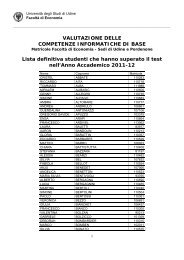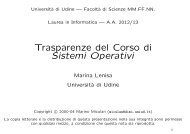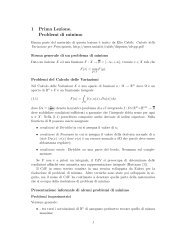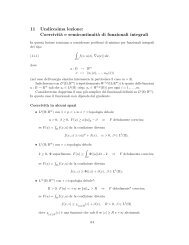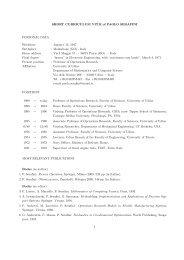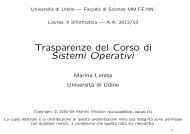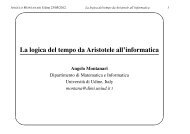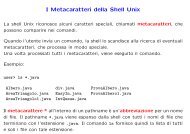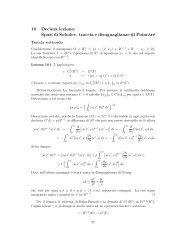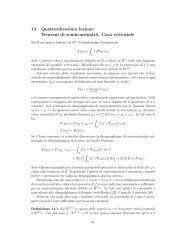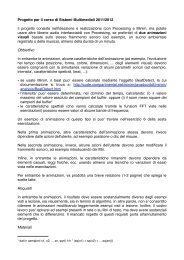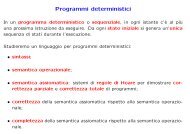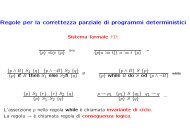Capitolo 9 - Dipartimento di Matematica e Informatica
Capitolo 9 - Dipartimento di Matematica e Informatica
Capitolo 9 - Dipartimento di Matematica e Informatica
Create successful ePaper yourself
Turn your PDF publications into a flip-book with our unique Google optimized e-Paper software.
BIBLIOGRAFIA 75<br />
Osservazione 9.20 L’ipotesi che µ sia non atomica non si può eliminare, infatti presi<br />
due elementi <strong>di</strong>stinti x1 e x2 <strong>di</strong> Ω e µ = δx1 + δx2 , allora L1 µ(Ω) è identificabile con R 2 ;<br />
infatti la funzione T : L 1 µ(Ω) → R 2 definita da F [ϕ] = ϕ(x1), ϕ(x2) è un’omeomorfismo<br />
lineare. Poiché esistono funzioni s.c.i. su R 2 che non sono convesse, le conclusioni del<br />
teorema non valgono in questo caso.<br />
Osserviamo anche che dal teorema precedente non segue in generale che se<br />
<br />
F (u) = f(x, u, ∇u) dx<br />
Ω<br />
è debolmente s.c.i. in W 1,1 (Ω; R m ) allora l’integrando f è convesso nella variabile gra<strong>di</strong>ente,<br />
perchè non tutte le funzioni v ∈ L 1 (Ω; R nm ) sono gra<strong>di</strong>enti <strong>di</strong> qualche funzione <strong>di</strong><br />
L 1 (Ω; R m ), 11 a meno che non sia n = 1.<br />
Tuttavia si <strong>di</strong>mostra che nei casi scalari (cioè non solo per n = 1 in cui la variabile<br />
x è scalare ma anche per m = 1 in cui u(x) è scalare) la convessità del funzionale nella<br />
variabile gra<strong>di</strong>ente oltre che essere con<strong>di</strong>zione sufficiente per la semicontinuità è anche<br />
necessaria. Vale ad esempio il teorema seguente.<br />
Teorema 9.21 Sia Ω un aperto limitato <strong>di</strong> R n ed f : Ω × R n → R un integrando <strong>di</strong><br />
Carathéodory. Sia p ∈ [1, +∞[. Supponiamo che esistano una funzione a ∈ L 1 (Ω) ed una<br />
costante b > 0 tali che<br />
|f(x, ξ)| ≤ a(x) + b|ξ| p .<br />
Consideriamo il funzionale F : W 1,p (Ω) → R definito da<br />
<br />
F (u) = f(x, ∇u) dx.<br />
Ω<br />
Se F è sequenzialmente debolmente semicontinuo inferiormente allora per q.o. x ∈ Ω la<br />
funzione ξ → f(x, ξ) è convessa.<br />
Bibliografia<br />
[1] H. Brezis, Analyse fonctionnelle. Théorie et applications., Masson, Paris, 1983.<br />
[2] G. Buttazzo, Semicontinuity, relaxation and integral representation in the calculus<br />
of variations, Pitman Res. Notes Math. Ser., vol. 207, Longman, Harlow, 1989.<br />
[3] V. Checcucci, A. Tognoli, and E. Vesentini, Lezioni <strong>di</strong> topologia generale, Feltrinelli,<br />
Milano, 1977.<br />
[4] G. Dal Maso, An introduction to Γ-convergence, Birkhäuser, Boston, 1993.<br />
[5] , Problemi <strong>di</strong> semicontinuità e rilassamento nel calcolo delle variazioni,<br />
Quaderni dell’Unione <strong>Matematica</strong> Italiana 39 (1995), 145–196.<br />
[6] E. De Giorgi, Teoremi <strong>di</strong> semicontinuità nel calcolo delle variazioni, Lezioni tenute<br />
all’Istituto Nazionale <strong>di</strong> Alta <strong>Matematica</strong>, a.a. 1968-69 Roma, 1969.<br />
11 Ricor<strong>di</strong>amo che già se v ∈ C 1 (Ω; R n ) (caso particolare m = 1) una con<strong>di</strong>zione necessaria affinchè esista<br />
ϕ tale che v = Dϕ è che rot v = 0. Ad esempio, nel caso n = 2, m = 1, la funzione v(x1, x2) = (1, x1)<br />
non è gra<strong>di</strong>ente <strong>di</strong> alcuna funzione ϕ : Ω → R. Infatti, se per assurdo lo fosse, cioè esistesse ϕ tale che<br />
1 = D1ϕ e x1 = D2ϕ allora, per il teorema del <strong>di</strong>fferenziale totale ϕ sarebbe <strong>di</strong> classe C 2 e si avrebbe<br />
D2(D1ϕ) = 0 = 1 = D1(D2ϕ) contro il teorema <strong>di</strong> Schwartz sull’inversione dell’or<strong>di</strong>ne <strong>di</strong> derivazione.<br />
Osserviamo che in tale caso rot v = D2v1 − D1v2 = D21 − D1(x1) = −1 = 0.



